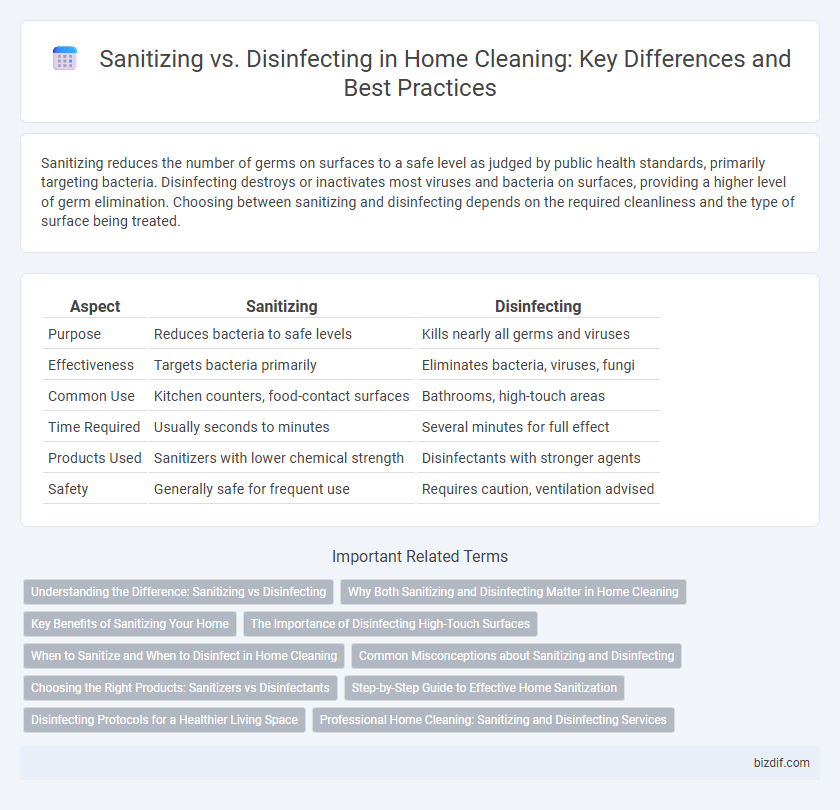Sanitizing reduces the number of germs on surfaces to a safe level as judged by public health standards, primarily targeting bacteria. Disinfecting destroys or inactivates most viruses and bacteria on surfaces, providing a higher level of germ elimination. Choosing between sanitizing and disinfecting depends on the required cleanliness and the type of surface being treated.
Table of Comparison
| Aspect | Sanitizing | Disinfecting |
|---|---|---|
| Purpose | Reduces bacteria to safe levels | Kills nearly all germs and viruses |
| Effectiveness | Targets bacteria primarily | Eliminates bacteria, viruses, fungi |
| Common Use | Kitchen counters, food-contact surfaces | Bathrooms, high-touch areas |
| Time Required | Usually seconds to minutes | Several minutes for full effect |
| Products Used | Sanitizers with lower chemical strength | Disinfectants with stronger agents |
| Safety | Generally safe for frequent use | Requires caution, ventilation advised |
Understanding the Difference: Sanitizing vs Disinfecting
Sanitizing reduces the number of germs on surfaces to a safe level, while disinfecting kills nearly all pathogens present. Sanitizers are ideal for everyday cleaning on items like countertops and kitchenware, whereas disinfectants are recommended for high-risk areas needing thorough microbial elimination. Knowing the distinction helps maintain a healthier home environment by applying the correct method based on contamination levels.
Why Both Sanitizing and Disinfecting Matter in Home Cleaning
Sanitizing reduces bacteria on surfaces to a safe level, while disinfecting kills a broader range of harmful pathogens including viruses and fungi. Utilizing both sanitizing and disinfecting methods in home cleaning ensures comprehensive protection against illness-causing microorganisms. This dual approach is crucial for maintaining a healthy living environment and minimizing the risk of infections.
Key Benefits of Sanitizing Your Home
Sanitizing your home reduces the number of germs on surfaces to a safe level, effectively minimizing the risk of infections and allergies. It helps maintain a cleaner environment by removing dirt and bacteria, promoting healthier indoor air quality. Regular sanitizing supports overall well-being by preventing the spread of common pathogens in high-touch areas like kitchen counters and bathroom fixtures.
The Importance of Disinfecting High-Touch Surfaces
Disinfecting high-touch surfaces like doorknobs, light switches, and countertops is crucial for eliminating harmful pathogens that regular sanitizing might miss. Effective disinfection uses EPA-approved products to kill viruses and bacteria, significantly reducing the risk of illness transmission in homes. Prioritizing these surfaces helps maintain a healthier living environment, especially during flu season or viral outbreaks.
When to Sanitize and When to Disinfect in Home Cleaning
Sanitizing is ideal for routine home cleaning to reduce bacteria to safe levels on surfaces like kitchen counters and dining tables, minimizing daily germ exposure. Disinfecting targets high-risk areas such as bathroom fixtures and frequently touched doorknobs, effectively eliminating viruses and bacteria during illness outbreaks or after contamination. Use sanitizers for general maintenance and disinfectants when there is a need to kill pathogens and prevent infections in the household.
Common Misconceptions about Sanitizing and Disinfecting
Many people confuse sanitizing with disinfecting, believing both processes eliminate the same amount of germs, but sanitizing only reduces bacteria to a safe level while disinfecting kills a broader range of pathogens, including viruses. Common misconceptions include assuming sanitizers are effective against all microbes or that disinfectants are safe for all household surfaces, which can lead to improper use and reduced effectiveness. Understanding the distinct purposes and proper applications of sanitizers and disinfectants is crucial for maintaining a truly hygienic home environment.
Choosing the Right Products: Sanitizers vs Disinfectants
Choosing the right products for home cleaning depends on understanding the difference between sanitizers and disinfectants. Sanitizers reduce bacteria levels to a safe standard, often used on food-contact surfaces, while disinfectants eliminate a broader spectrum of pathogens, including viruses, making them ideal for high-touch areas. Selecting products based on EPA registration and label instructions ensures effective use and optimal home hygiene.
Step-by-Step Guide to Effective Home Sanitization
Sanitizing reduces the number of germs on surfaces to a safe level, while disinfecting kills nearly all pathogens, including bacteria and viruses. Start by cleaning surfaces with soap and water to remove dirt, then apply an EPA-registered sanitizer or disinfectant according to the label instructions. Ensure proper contact time for the product to work effectively, and prioritize high-touch areas like doorknobs, light switches, and countertops for comprehensive home sanitization.
Disinfecting Protocols for a Healthier Living Space
Disinfecting protocols in home cleaning involve using EPA-approved products that eliminate 99.9% of harmful pathogens on surfaces, reducing the risk of infections and promoting a healthier living environment. Effective disinfecting includes targeting high-touch areas such as doorknobs, light switches, and countertops with appropriate dwell times to ensure microbial eradication. Consistent application of these protocols boosts indoor hygiene standards and supports overall well-being by minimizing exposure to viruses and bacteria.
Professional Home Cleaning: Sanitizing and Disinfecting Services
Professional home cleaning services specialize in both sanitizing and disinfecting to reduce harmful pathogens and maintain a healthy living environment. Sanitizing lowers the number of germs on surfaces to a safe level, while disinfecting kills a higher percentage of bacteria and viruses, providing deeper protection against infectious diseases. Expert cleaning teams use EPA-registered products and industry-approved techniques to ensure thorough sanitization and disinfection tailored to homeowners' specific needs.
Sanitizing vs Disinfecting Infographic

 bizdif.com
bizdif.com